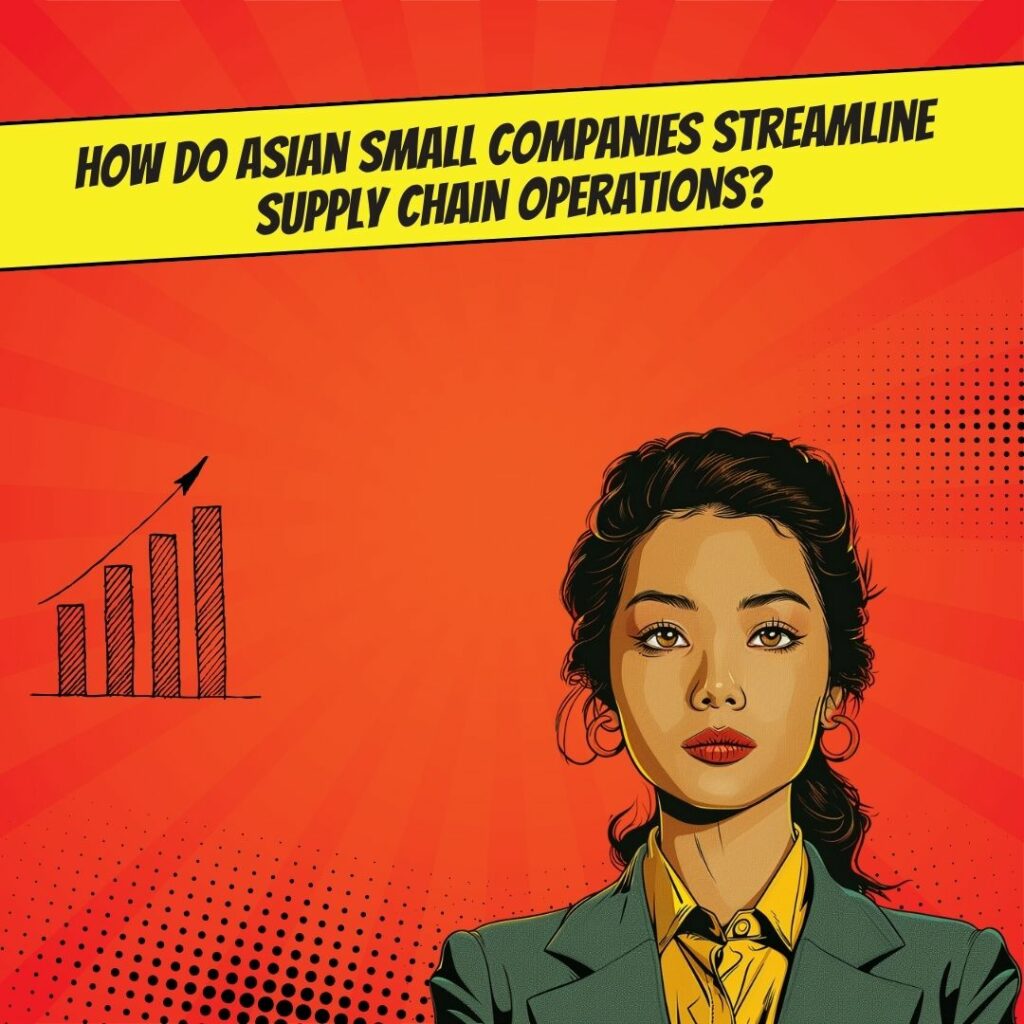Key Takeaways
✅ Embracing Technology and Collaboration: Asian SMEs are leveraging digital tools such as AI, IoT, and blockchain to improve supply chain visibility and efficiency. Businesses can adopt these technologies to better manage inventory and logistics.
✅ Implementing Lean and Agile Strategies: These companies are using lean and agile methods to minimize waste and reduce costs. Consider implementing a hybrid approach to optimize different parts of your supply chain for better responsiveness.
✅ Fostering Proximity to Customers and Strategic Partnerships: SMEs are establishing local distribution centers and forming strategic partnerships to enhance supply chain resilience and improve customer satisfaction. Evaluate your distribution network and partnerships to see where you can improve proximity and collaboration.

Introduction
How are Asian small companies transforming their supply chains to stay in the game amid global challenges? The COVID-19 pandemic and the Ukraine conflict have disrupted traditional supply chains, forcing Asian SMEs to adapt like never before. Effective supply chain management isn't just an option—it's a necessity for these enterprises to respond quickly to market shifts. Many companies are ditching old models of lean inventory and just-in-time delivery in favor of more resilient strategies.
So, what are the secrets behind their innovative approaches? In this article, we'll explore how these companies are using technology, adopting different supply chain strategies, and forming strategic partnerships to stay competitive and satisfy customers. From warehouse automation to micro-fulfillment centers, get ready to learn actionable insights that can revolutionize your supply chain and maximize your revenue.
Top Statistics
| Top Statistics | Insight |
|---|---|
| Southeast Asia is the top choice for firms diversifying away from China: This trend follows the 'China Plus One' strategy, where businesses expand into countries like Vietnam and Indonesia to reduce overreliance on China. | This trend illustrates the strategic importance of diversification in mitigating regional risks and ensuring operational resilience. |
| Increased foreign direct investments in ASEAN region: The region attracted $236 billion in foreign direct investments in 2023, up from the average of $190 billion annually between 2020 and 2022. | The influx of investments underscores the growing attraction of the ASEAN region as a manufacturing and business hub. |
| Rethinking supply chains in Asia Pacific: The COVID-19 pandemic exposed supply chain vulnerabilities, prompting multinational companies to reassess their global manufacturing and sourcing approaches. | Companies are adopting strategies like regionalization and replication to minimize disruption and increase supply chain resilience. |
The Need for Adaptation
Small and medium-sized enterprises (SMEs) in Asia are currently facing significant challenges, with global supply chains being disrupted by factors like the COVID-19 pandemic and the Ukraine conflict. These issues have compelled many SMEs to rethink their supply chain strategies, moving away from traditional models that relied heavily on lean inventories and just-in-time delivery. Such older strategies, while efficient in stable times, have proven to be risky amid current global uncertainties.
Effective Supply Chain Strategies
SMEs are recognizing the need for more flexible supply chain strategies to stay competitive and resilient. Companies are now exploring different approaches like lean, agile, and hybrid strategies. Lean strategies focus on cutting waste and improving efficiencies, whereas agile strategies aim for quick responses to changing market demands. Hybrid strategies combine elements of both, allowing firms to be both efficient and responsive. By leveraging technology and strategic partnerships, these companies are better positioned to capitalize on their core competencies.
The Role of Technology
Advanced technologies are playing a crucial role in transforming supply chains. Tools like artificial intelligence (AI), the internet of things (IoT), and blockchain are helping companies to improve efficiency and visibility. AI can analyze vast amounts of data to predict demand and optimize inventories. IoT devices can track shipments in real-time, providing end-to-end transparency. Blockchain technology enhances security and trust by offering an immutable record of transactions. These technologies enable SMEs to automate processes, collaborate more effectively with partners, and make data-driven decisions.
Real-Life Examples of Success
There are numerous Asian SMEs successfully implementing these strategies to achieve significant improvements. For instance, AutoStore has effectively utilized warehouse automation to boost throughput and free up valuable space. This not only allowed the company to operate more flexibly but also enhanced customer satisfaction. Case studies from companies like AutoStore illustrate how leveraging warehouse automation can provide a competitive edge, improve operational efficiency, and enable firms to adapt to changing market conditions.
By integrating strategic supply chain planning with advanced technology, SMEs can navigate today's complex market dynamics more effectively. The adoption of newer, more adaptive supply chain strategies can help them maintain customer loyalty and support long-term success.
AI Marketing Engineers Recommendation
Recommendation 1: Leverage Predictive Analytics for Inventory Management: Small companies in Asia are using predictive analytics to streamline their supply chains. By analyzing historical data and current market trends, firms can predict demand and optimize their inventory levels. According to a 2022 study by Statista, companies employing predictive analytics in supply chain management saw a 15% reduction in excess inventory and a 20% improvement in order fulfillment rates. For any business looking to streamline operations, integrating predictive analytics tools could be a game-changer.
Recommendation 2: Embrace E-commerce Integration to Enhance Supply Chains: With e-commerce continuing to grow—global e-commerce sales reached $4.9 trillion in 2021—Asian small businesses are increasingly integrating their supply chains with e-commerce platforms. This approach not only increases market reach but also allows real-time tracking and more efficient logistics. Research from McKinsey & Company reveals that firms incorporating e-commerce saw a 23% increase in operational efficiency. Companies should consider adopting e-commerce solutions that sync seamlessly with their supply chain systems to stay competitive.
Recommendation 3: Utilize Cloud-Based Supply Chain Management Software: Many Asian small companies are turning to cloud-based software to manage their supply chains more effectively. These platforms offer real-time data access, improve collaboration across various departments, and simplify complex processes. According to Gartner, 50% of global enterprises are expected to use cloud-based supply chain solutions by 2023, up from 40% in 2020. By adopting cloud-based SCM software, businesses can experience increased agility, reduced costs, and enhanced data security, making it a practical tool for optimization.
Relevant Links
- Welcome to AiMarketingEngineers.com: Transform Your Marketing
- Campaign Reach and Audience Size: Driving Business Success
- Enhancing Customer Loyalty with Engagement Strategies
- Improving Market Predictions with Sales Forecasting
Conclusion
The ability of Asian small companies to streamline their supply chains highlights the importance of strategic thinking and innovation. These businesses have demonstrated that even with limited resources, it is possible to create efficient and effective supply chain systems. By leveraging technology and building strong partnerships, they have managed to stay competitive in a crowded market. This approach serves as a powerful example for other small companies worldwide facing similar challenges.
Collaboration is a key factor in the success of these streamlined operations. By working closely with suppliers, distributors, and other stakeholders, these companies can optimize every link in their supply chain. This collaborative approach not only reduces costs but also improves service delivery and customer satisfaction. Other small businesses can learn from this model, adopting similar strategies to enhance their own supply chain efficiency.
Looking ahead, the continued focus on supply chain optimization by Asian small companies will likely influence global supply chain practices, pushing the industry towards more sustainable and efficient models. As these companies continue to innovate and adapt, they will set new standards for supply chain management that can be adopted by businesses around the world. The future of supply chain management will be shaped by these pioneering efforts, driving the industry towards greater efficiency and resilience.
FAQs
Question 1: What is a supply chain strategy?
Answer: A supply chain strategy outlines a company's approach to managing the flow of goods, information, and finances from procurement to delivery, ensuring efficiency and effectiveness in meeting customer demands.
Question 2: Why is supply chain management critical for business success?
Answer: Supply chain management is crucial because it influences a company's ability to reduce costs, satisfy customers, achieve competitive advantage, manage risks, and foster innovation and sustainable growth.
Question 3: What are the main types of supply chain strategies?
Answer: There are five main types of supply chain strategies: lean, agile, customization, postponement, and hybrid approaches.
Question 4: How can technology enhance supply chain strategies?
Answer: Technology plays a crucial role in enhancing supply chain strategies by providing tools for better data analysis, real-time tracking, automation, and collaboration among supply chain partners. Advanced technologies like AI, IoT, and blockchain can significantly improve efficiency, visibility, and security across the supply chain.
Question 5: What is the role of warehouse automation in supply chain management?
Answer: Warehouse automation, such as AutoStore, can increase throughput, free up space, operate more flexibly, and bring inventory closer to customers, reducing delivery times and enhancing business performance.
Question 6: How can companies implement multiple supply chain strategies simultaneously?
Answer: Companies can adopt a hybrid approach, combining different strategies for different products or markets. For example, a lean approach for mature products and an agile strategy for new offerings.
Question 7: How can small businesses implement advanced supply chain strategies?
Answer: Small businesses can leverage technology, form strategic partnerships, and focus on core competencies to enhance their competitiveness. They can adopt lean principles, agile methodologies, and customization strategies to improve efficiency and customer satisfaction.
Question 8: What are the benefits of a resilient supply chain strategy?
Answer: A resilient supply chain strategy empowers businesses to swiftly navigate through disruptions, guaranteeing continuous operations and service delivery to customers, which is crucial for maintaining trust and satisfaction.
Question 9: How can companies like Shein achieve success through innovative supply chain strategies?
Answer: Companies like Shein can achieve success by minimizing inventory, responding to consumer demand in real time, and leveraging digitized supply chains to better match customer demand and supply, minimizing production waste.
Academic References
- Flynn, B., Huo, B., & Zhao, X. (2010). Supply Chain Process Integration: A Theoretical Framework Journal of Operations Management, 28(2), 58-71. This study provides a theoretical framework for supply chain process integration, drawing from four theories: Strategy-Structure-Performance, Resource-Based View, Transaction Cost Economics, and Social Network Theory.
- Tian, F. (2016). Blockchain Technology in Supply Chain Operations Supply Chain Innovation: Emerging Technologies, 95-110.
This paper reviews how blockchain technology can enhance supply chain operations by providing a decentralized, transparent, and traceable system for tracking and managing supply chain processes. - Ivanov, D., Dolgui, A., & Sokolov, B. (2019). Digitalization in Supply Chain Management and Logistics International Journal of Production Research, 57(3), 865-876. Digitalization is transforming supply chain management and logistics by introducing new business models and technologies that improve efficiency and customer satisfaction.
- APEC SME Working Group. (2001). APEC SME 2001 Conference on Strategic Alliances for Efficient Supply Chain Management Asia-Pacific Economic Cooperation Secretariat, Singapore. This conference highlighted the importance of strategic alliances for small and medium-sized enterprises (SMEs) to improve their supply chain management and competitiveness.












